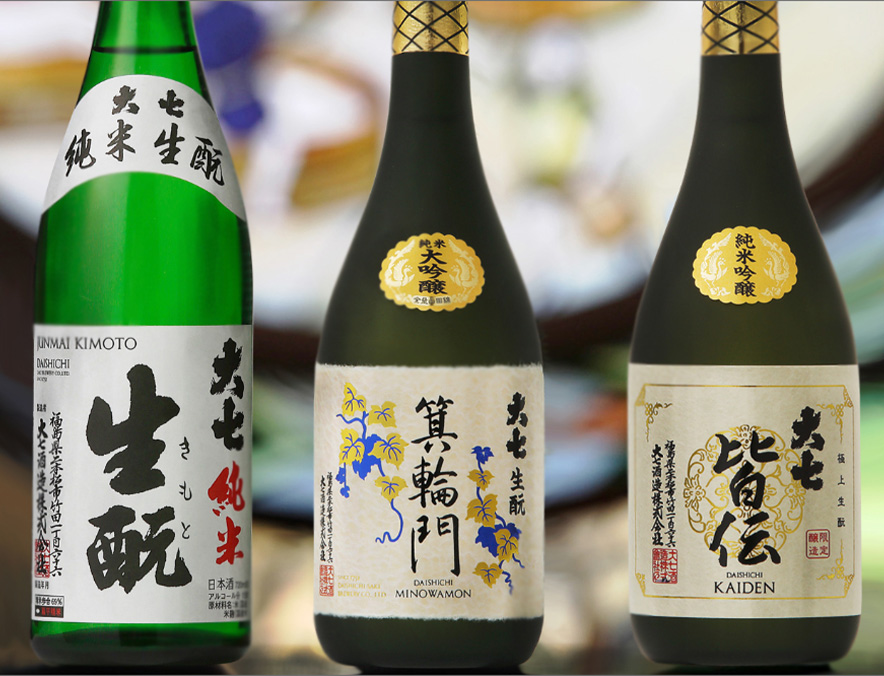[The characteristics of Kimoto sake]
Enter the world of Kimoto and you'll find yourself in a realm of quality and richness that modern sake-making methods simply cannot match. We believe that the distinction is more profound than merely the difference in rice polishing ratios. So what is the secret? The depth of flavor.
Flavor
Kimoto brewing is a byword for lush, deep richness. The Kimoto method allows more than twice the time used in ordinary sake-brewing for complex microbial transformations. The sake is brought slowly to completion at a low temperature, so that a wide variety of elements can blend perfectly in a harmony of flavor that cannot be achieved with more simplistic modern methods. A solid framework and a structured feel similar to that of good wine. It will be even more wonderful after maturing for another two or three years. A balanced smoothness, great delicacy and profound depth. A comforting and mellow flavor is complemented by outstanding crispness. The aftertaste is also wonderful: an all-enveloping vitality, like a forest glade.
A natural aroma
The fundamental notes of the kimoto bouquet are freshly-steamed Japanese rice, almond, the rounded scent of coconut, such creamy aromas as yogurt and fresh cream, the freshness of forests and springs, the tang of cypress, pine and cedar vats, and the spice of such fragrant woods as aloeswood and sandalwood. Ginjo sake made with the kimoto method offers an elegant bouquet of such sweet fruit fragrances as pear, peach, and melon, along with flowery scents as jasmine and daphne.
You need a large glass to fully appreciate the aroma. Pour enough sake to fill the glass to around a third full, then swirl it gently to enjoy a symphony of aromatic notes. A natural bouquet, with an elegant simplicity in which showy scents are not overpowering. Here, fragrance and flavor unite. The sake contains many natural scent-preserving compounds, so the wonderful aroma does not dissipate even after the bottle has been opened. Instead it continues to evolve.
A perfect match with food
Kimoto sake is the perfect complement for the perfect meal. Kimoto sake has a wealth of savory flavor constituents, making it robust and acidic. Consequently, it is rarely susceptible to loss of flavor or becoming watery when drunk with food. The large amount of lactic acid in kimoto sake means that it goes well even with dishes that use butter, cream or cheese.
The amino acids that characterize kimoto sake can hold their own with dishes featuring intense and savory flavors. Kimoto sake also cleans the palate after a deliciously oily food. If a meal features especially pungent flavors, the sake can be heated to make it even more effective. Kimoto sake is not just an aperitif; it can and should be enjoyed with the meal. It suits Japanese cuisine, of course, but also Western and Chinese cooking. It is an all-inclusive, exceptionally versatile drink.
The pleasures of warm sake
“Securing top place in the ‘warm sake’ category is Daishichi of Fukushima. Despite the general trend towards sokujomoto-type, light sakes, since its inception this brewery has focused purely on Kimoto sake. The plentiful acid forms the backbone of a solid sake that has a gutsy quality and also outstanding crispness. When warmed, the dryness becomes more apparent, and the palate-cleansing sensation is exceptional. (...) Fine either lukewarm or warm. A fantastic sake, both powerful and clean.”
[From monthly magazine Dancyu (February issue, 1999, published by President Inc.). These comments were made on the occasion of Daishichi Junmai Kimoto sake’s selection as the “number one warm sake in Japan.”]
"I suspect the true aspect of Japanese sake is that one can drink it warm without ever tiring of it." [Usuke Asai in Ways to View Sake.]
“O-kan”, the custom of drinking sake warm, has recently attained renewed popularity in Japan as its virtues are rediscovered. Warming sake endows it with qualities that aren’t apparent at cooler temperatures. There is an extra pleasure in discovering a sake that becomes even more attractive when warmed.






